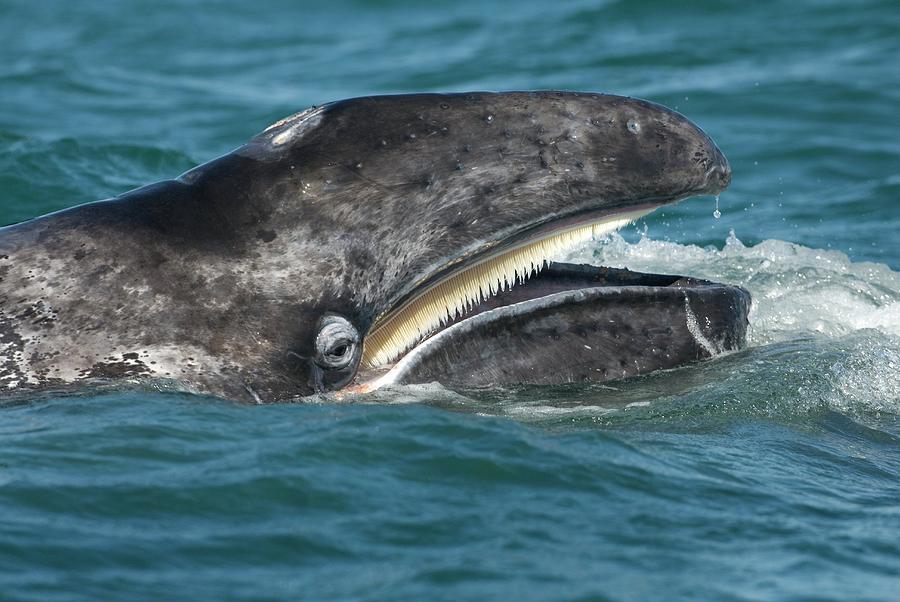
Systematic counts of Eastern North Pacific gray whales migrating south along the central California coast have been conducted by shore-based observers at Granite Canyon most years since 1967. Photo-identification studies indicate that gray whales in this stock move widely within and between areas on the Pacific coast, are not always observed in the same area each year, and may have several year gaps between re-sightings in studied areas (Calambokidis and Quan 1999, Quan 2000, Calambokidis et al. From mid-February to May, the Eastern North Pacific stock of gray whales can be seen migrating northward with newborn calves along the West Coast of the U.S. Calves are born in shallow lagoons and bays from early January to mid-February. In the fall, gray whales migrate from their summer feeding grounds, heading south along the coast of North America to spend the winter in their breeding and calving areas off the coast of Baja California, Mexico. Most of the Eastern North Pacific stock spends the summer feeding in the northern Bering and Chukchi Seas, but gray whales have also been reported feeding along the Pacific coast during the summer, in waters off of southeast Alaska, British Columbia, Washington, Oregon, and California. There are two isolated geographic distributions of gray whales in the North Pacific Ocean: the Eastern North Pacific stock, found along the west coast of North America, and the Western North Pacific or "Korean" stock, found along the coast of eastern Asia. Gray whales are found mainly in shallow coastal waters in the North Pacific Ocean. Killer whales ( Orcinus orca) are the only non-human predator of gray whales. The age of large whales in family Balaenopteridae can be estimated by counting the layers present in waxy ear plugs, which are formed in the auditory canal (Hohn 2002). The average and maximum life span of gray whales is unknown, although one female was estimated at 75-80 years old after death (Jones and Swartz, 2002). Newborn calves are approximately 14-16 ft (4.5-5 m) long, and weigh about 2,000 lb (920 kg). After 12-13 months of gestation, females give birth to a single calf. Gray whales become sexually mature between 6-12 years, at an average of 8 years old. In doing so, they often leave long trails of mud behind them, and "feeding pits" in the sea floor. To do this, they roll on their sides and swim slowly along, filtering their food through coarse baleen plates, of which they have 130-180 on each side of the upper jaw. Gray whales are bottom feeders, and suck sediment and the "benthic" amphipods that are their prey from the sea floor. Similar to other baleen whales, long-term bonds between individuals are rare. Gray whales are frequently observed traveling alone or in small, unstable groups, although large aggregations may be seen on feeding and breeding grounds. All gray whales are mottled with lighter patches, and have barnacles and whale lice on their bodies, with higher concentrations found on the head and tail. Calves are born dark gray and lighten as they age to brownish-gray or light gray. The tail flukes are more than 15 ft (3 m) wide, have S-shaped trailing edges, and a deep median notch.

#GRAY WHALE SERIES#
Lacking a dorsal fin, they instead have a "dorsal hump" located about two-thirds of the way back on the body, and a series of 8-14 small bumps, known as "knuckles," between the dorsal hump and the tail flukes.

Their "pectoral fins" (flippers) are broad, paddle-shaped, and pointed at the tips. They have a mottled gray body, with small eyes located just above the corners of the mouth. These large whales can grow to about 50 ft (15 m) long, and weigh approximately 80,000 lb (35,000 kg). Gray whales are the only species in the family Eschrichtiidae. Gray whales are mysticetes, or baleen whales. MMPA Depleted - Western North Pacific populationĭelisted from ESA - Eastern North Pacific population ESA Endangered - Western North Pacific population


 0 kommentar(er)
0 kommentar(er)
